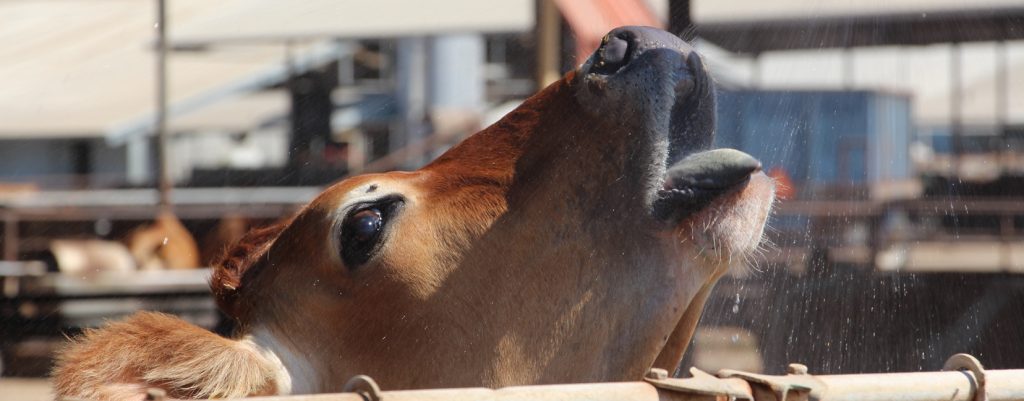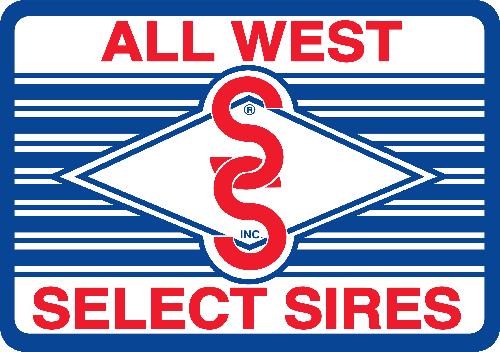
It’s not a matter of “if” it gets hot, but “when” it will do so. Dealing effectively with heat stress in dairy herds is essentially a management issue. High levels of humidity aggravate heat stress. Dairy cows are homoeothermic animals and need to maintain a constant body temperature of around 101°F. They are sensitive to factors which influence their thermal exchange with the environment. These factors include air temperature, radiant temperature, air velocity and relative humidity.
The comfort zone, or thermo-neutral zone, for a dairy cow is wide varying from around 5°F to 77°F.
At temperatures above 77°F, cows have two main control strategies to maintain their thermal balance. Air containing higher levels of water vapor reduces the potential for evaporation by cooling in a cow’s environment. If body heat is not allowed to dissipate by way of evaporation of sweat or water applied to the cow, the cow retains that heat and becomes more uncomfortable. A cow’s next response is to start panting to get cool air into her body. Even if humans are not feeling discomfort in a warm barn, a barn full of panting cows indicates that the cows are already experiencing heat stress.
Improving heat dispersion, in particular evaporation, by increasing subcutaneous blood flow, panting and drooling escalate the maintenance energy needs of the animal by an estimated 20 percent at 95°F. This means the cow will re-direct her thermal regulation, lowering milk production, heat expression and conception. Limiting heat production, by reducing activity and changing the feeding pattern is a common practice. As the majority of heat production is essentially due to rumen fermentation the cow will reduce her dry matter intake by up to 30 percent. She will also be selective in what she will eat if given a choice, namely less fiber. Cows suffering from heat stress quickly stop eating largely in an effort to diminish the heat coming from rumen fermentation. The reduction in feed intakes will reduce milk production and put the cow at risk for various health issues. Because higher producing cows have higher feed intakes, they produce more metabolic heat and will be at greater risk. During periods of heat stress and reduced nutrient intake, cows can quickly fall into a negative energy balance. Less feed in the rumen means less fermentation and volatile fatty acid production as well as a reduction in rumen microbes and metabolizable protein. This results in fewer nutrients being available for milk production and reproduction.
Tips to Managing Heat Stress
The most practical methods to reduce heat stress can be grouped into ventilation and cooling. Common areas where cows congregate that will benefit from a reduction in heat exposure include the milking parlor holding pen, feed areas and freestalls. The installation of fans and sprinkler systems are often promoted as the solution for heat abatement. In many cases there could be significant benefits from a mechanical solution, but this will involve capital investment and more operating costs. On too many farms, fans have been installed before simple improvements to basic ventilation have been made, such as opening up side wall ventilation and ridge vent ventilation to grow the chimney effect and allow hot air to escape the barn. The installation of a mechanical solution should be considered after natural ventilation improvements have been considered and implemented. An assessment of airflows within an existing building can be carried out quickly and easily using a smoke cartridge to determine where physical improvements should be made before embarking on a mechanical ventilation solution.
Improving airflow over a cow has a dramatic effect on evaporative heat loss from the skin. Research studies suggest that air flows as low as 5 mph can reduce respiration rates in heat stressed animals by as much as 50 percent. The installation of fans, combined with spraying water onto cows, can dramatically reduce the effects of heat stress. Cows should be wetted at the head locks with 2.5 gallons of water over a period of 60 seconds followed by four minutes of drying with a 0.6 mph airflow. Others suggest that when the temperature exceeds 70°F, a spray cycle should include the application of one gallon per cow over a period of three minutes followed by 12 minutes of air movement to increase evaporative cooling.
The application of water in the feeding area has proved very effective, but researchers have concluded that the benefits are reduced unless the wetting is combined with fans and therefore evaporative losses. One down side is that application of water to cows around the bedded area can get the freestalls or bedded pack wet and ultimately increase the chance for mastitis.
Changing feeding times can also be helpful. Feeding 60 percent of the summer ration between 8:00 p.m. and 8:00 a.m. will improve intakes. Cows will tend to eat less during the day, but more often and in smaller quantities. They will tend to consume more feed at night when it is cooler, minimizing slug feeding, sorting of feed and the tendency to choose feeds (grains and over forages) that produce less heat during digestion. Water is critical. Cows are unlikely to walk more than 825 feet to drink so it is essential that water tanks are near to encourage drinking. As temperatures rise, cows will drink more. In hot weather, water intakes can increase by 10-20 percent, so it is essential to have adequate water troughs. When temperatures rise, cows can drink in excess of 25 gallons/day, even the lower yielding cows.
Heat Stress and Reproductive Performance
Alongside things typically associated with heat stress, like less milk and component production and dry matter intake, heat stress can negatively influence reproductive performance.
Heat detection. Both duration and intensity of estrus are negatively affected by heat stress. Cows attempting to reduce body heat production limit their physical activity, translating to fewer physical signs of estrus, which makes heat detection more difficult.
Fertility. Pregnancy rate is reduced by decreased fertility resulting from impeded development of mature follicles. Premature follicles emerge around 40 days prior to ovulation, making oocytes susceptible to heat-related damage, which can compromise quality almost immediately.
Embryonic development. Embryonic development, especially through day 40, is vulnerable to heat stress. Elevating the cow’s internal temperature results in a reduction in the number of embryos that continue to develop. As the cow tries to thermo-regulate, her system will redistribute blood flow away from her core. This aids in dissipating heat, but reduces blood flow supporting fetal development and supplying the uterine body.
Summer weather makes a convincing argument to utilize detection aids, including CowManager®, tail chalk and tail patches. Timed-A.I. protocols such as double ovsynch or pre-synch ovsynch are particularly useful to bypass the often nonexistent signs of estrus. Contact your Select Sires Select Reproductive (SRS) specialist to determine the strategies that will be appropriate for your dairy.
To minimize potential problems with heat stress dairy producers need to be prepared and monitor the symptoms of heat stress. Changing facilities and management to account of summer temperatures will lessen the effect on milk production and reproduction. Heat stress can have long-term effects on conception and pregnancy rates, lower milk production and increase health problems, resulting in lowered profitability.

 .
. .
. .
. .
. .
. .
.